To hose who neither have frozen shoulder nor rotator cuff tears.
<For those who continue to experience shoulder pain despite being diagnosed with no abnormalities in tests.>
【Introduction】
Have you ever experienced persistent shoulder pain despite being diagnosed by a doctor with 'no particular abnormalities on X-rays or MRIs'? For such individuals, I would like to introduce the condition known as biceps tendon injury.
Among shoulder-related ailments, frozen shoulder is a well-known condition. Additionally, rotator cuff tears have increasingly been featured on medical information TV programs and health-related media such as magazines and advertisements, gaining recognition among the general public.
When experiencing prolonged shoulder pain, some may suspect the more widely recognized rotator cuff tear and visit a hospital. After undergoing MRI scans, an orthopedic doctor might say, 'The MRI shows no tendon tears or abnormalities. It’s probably frozen shoulder. The pain is likely to be temporary, so I’ll prescribe you some medication and patches; let’s monitor it for a while,' or 'Here’s a guide for shoulder exercises,' or even 'Let’s start rehabilitation at the hospital.' Many individuals continue with self-exercises or hospital rehabilitation but still find their shoulder pain unrelieved, which brings them to my clinic quite frequently.
Here, I would like to share my experience with such cases where individuals have undergone treatments like injections and rehabilitation at other hospitals without improvement, only to discover that biceps tendon injury was the primary cause of their persistent shoulder pain. I’ll share my diagnostic approach, as well as strategies for conservative and surgical treatments. As an example of a patient who underwent surgery, I will talk about my own mother. I am confident that this section will serve as a valuable reference for those who continue to suffer from shoulder pain despite being told by a doctor that their X-rays and MRIs showed no abnormalities, nor signs of rotator cuff tears.
『What is the biceps tendon?』
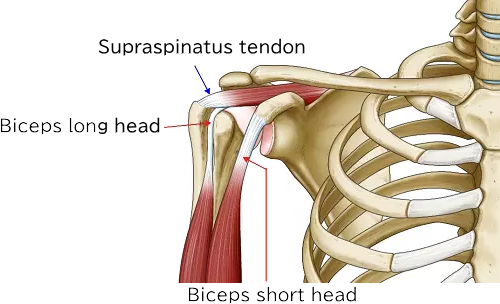

The 'biceps brachii' refers to the muscle that forms the bulge known as the biceps.
"This muscle not only assists in bending the elbow but also supports the movement of the shoulder joint. The biceps brachii becomes tendinous, with one end attached to the shoulder joint and the other to the elbow joint. It spans from the elbow to the shoulder, where it splits into two tendons: the 'long head' and the 'short head.' The 'long head' is positioned in the intertubercular groove (a narrow, recessed groove on the humeral head of the shoulder joint) due to the bone's shape, making it more prone to frictional effects and bearing greater stress than the 'short head.'"
『Mechanism of Biceps Tendon Injury』
- When a labrum injury occurs in the shoulder joint, it places additional strain on the long head of the biceps tendon.
- Injuries to the supraspinatus tendon or subscapularis tendon act as triggers, placing stress on the biceps tendon.
Primarily, these two factors contribute to the occurrence of the injury.
Let me explain further in detail.
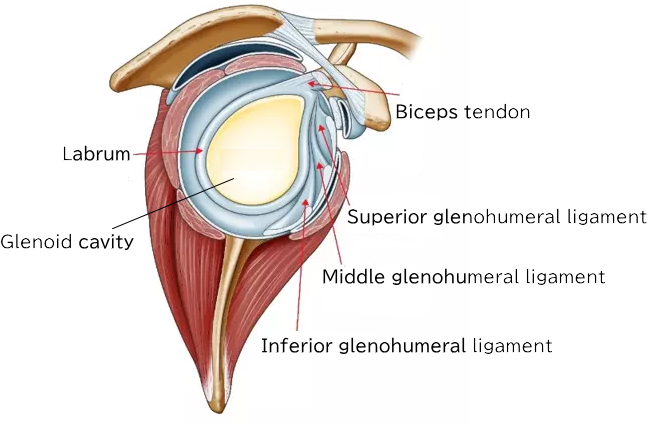
Please refer to the illustration above.
The long head of the biceps tendon passes through the intertubercular groove and enters the joint, where it connects to the labrum. The labrum is a type of cartilage that firmly adheres to the bone known as the glenoid, which is part of the scapula (the socket for the humeral head).
When the labrum detaches (is damaged) from the glenoid, it places strain on the biceps tendon. This strain causes abnormal movements of the biceps tendon within the intertubercular groove, which negatively affects it. Prolonged abnormal movements increase friction within the groove, leading to tendon damage over time. This is the typical progression of events.


Even in the absence of a labrum injury, damage to parts of the rotator cuff, such as the supraspinatus tendon or subscapularis tendon, can increase friction on the long head of the biceps tendon within the intertubercular groove. This can lead to damage to the tendon or exacerbate the severity of an existing injury.
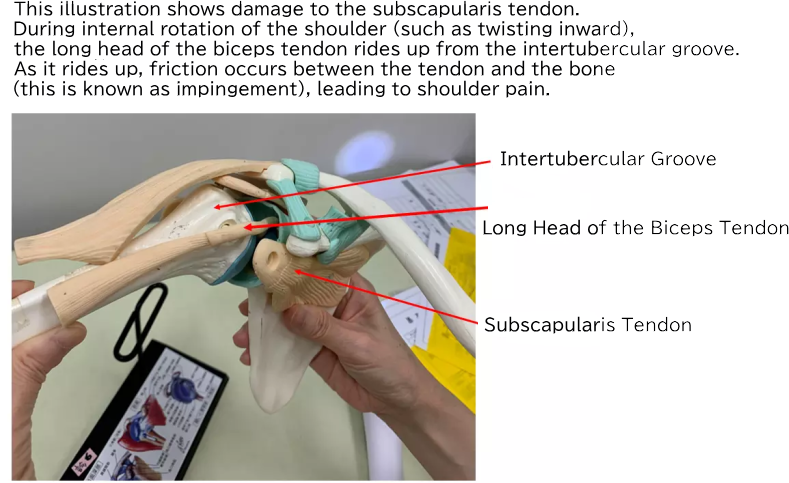
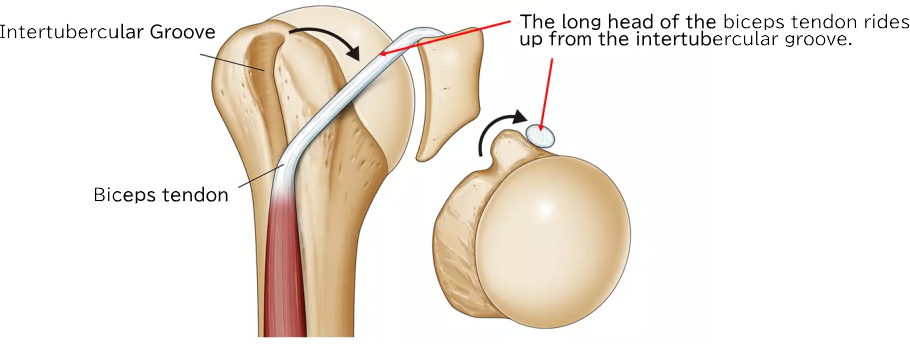

Mechanism of Onset
- Falling and landing on your hand
- Severely hitting your shoulder
- Overextending the shoulder while reaching back to retrieve items from the rear seat of a car
- Repeated lifting and lowering of heavy objects
These are representative triggers.
Main Symptoms
- Difficulty raising the arm due to pain, but it is not entirely impossible to lift it.
- Pain in the front of the shoulder.
- Pain occurring when the arm is moved behind the back.
- Pain arising when trying to move the arm across to touch the opposite shoulder.
Condition of the Shoulder
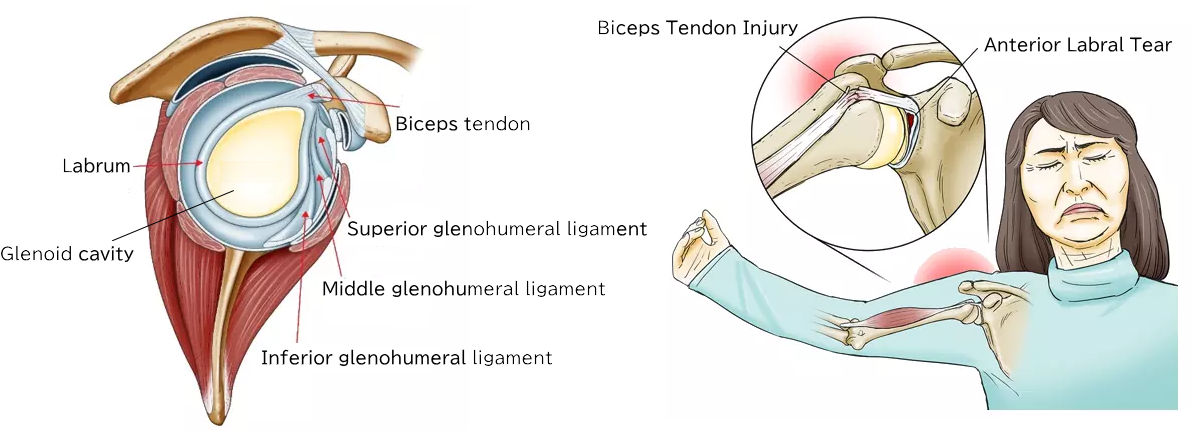
Diagnosis:
The diagnosis is conducted through physical examination and imaging tests such as MRI. On MRI scans, fluid accumulation is often observed. However, even when fluid is present in the intertubercular groove on MRI, many individuals experience no pain. Therefore, the presence of fluid serves as a reference finding that may suggest the possibility of biceps tendon injury.
In physical examination:
- Pain in the front of the shoulder
- Pain when moving the arm behind the back
- Pain when trying to move the arm across to touch the opposite shoulder
These symptoms are evaluated to determine their presence.
Criteria for Diagnosing Biceps Tendon Injury
- At least one of the three physical findings mentioned above is observed.
- Fluid accumulation in the intertubercular groove of the long head of the biceps tendon is detected on MRI or ultrasound, or one of the following injuries is observed: subscapularis tendon injury, supraspinatus tendon injury, or labrum injury.
- Tenderness around the intertubercular groove.
If these criteria are met, a diagnosis of biceps tendon injury is made.
Treatment (Refer to the Shoulder Diseases section as well)
Conservative Therapy
- Under ultrasound guidance, a local anesthetic containing steroids is injected into the intertubercular groove. If the pain improves, it is determined that biceps tendon injury is the primary cause of the shoulder pain. It is often observed that repeated injections can help individuals resume their daily activities without difficulty.
Physical therapy (rehabilitation) is conducted in conjunction with injection therapy.
Surgical Therapy
The procedure performed is a biceps tenodesis. While several techniques for the surgery have been reported, two methods will be introduced here.
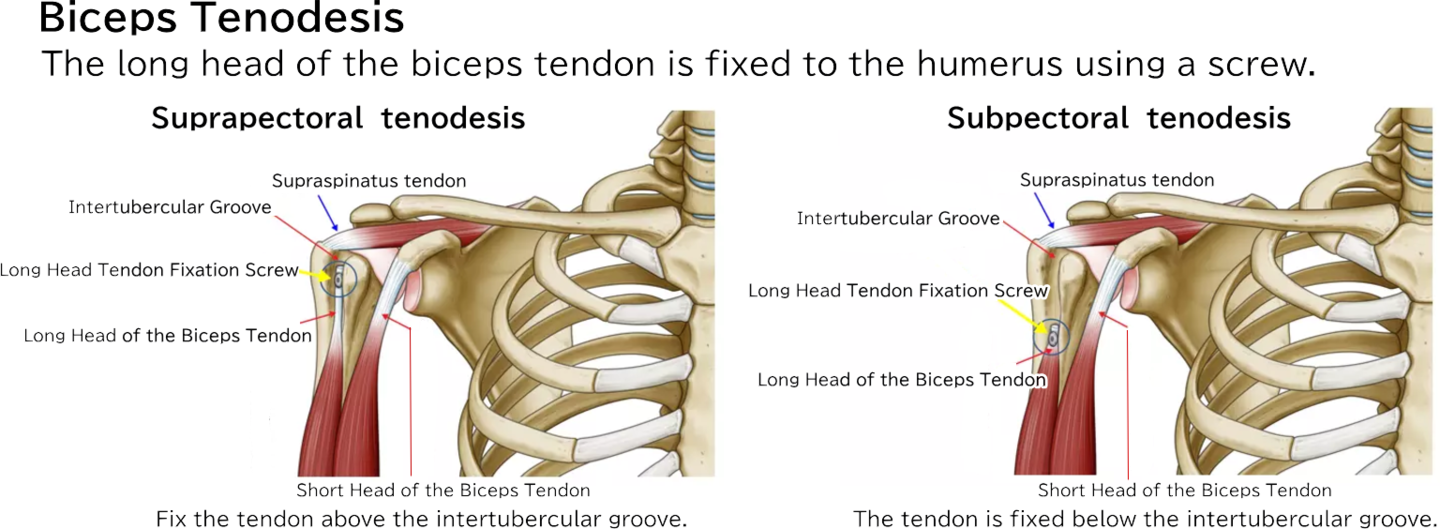
There is no definitive conclusion yet as to which surgical technique, Suprapectoral tenodesis or Subpectoral tenodesis, is superior. However, since the extent of biceps tendon injuries can sometimes be extensive (reaching below the intertubercular groove), some researchers advocate that Subpectoral tenodesis results in less postoperative shoulder pain. At present, I personally prefer performing Subpectoral tenodesis.
A Case of Biceps Tendon Injury Successfully Treated with Surgery
As mentioned earlier, the patient is my mother. At the age of 66, she developed pain in her left shoulder. While I was in the United States, she emailed me about her struggles with shoulder pain. She visited a nearby clinic and received multiple hyaluronic acid injections, which temporarily alleviated the pain but did not eliminate it entirely.
After completing my studies abroad and returning to Japan, I examined my mother. I will present her range of motion and examination findings through videos.
In this video, my mother's shoulder shows excellent range of motion, and her shoulder moves well. However, pain occurs at certain angles. The pain becomes more intense when the shoulder is abducted and externally rotated. The illustration below depicts the state of the shoulder joint during abduction and external rotation.
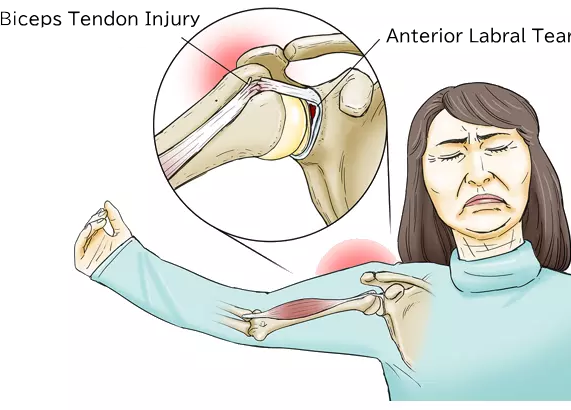
There is tenderness in the intertubercular groove at the front of the shoulder.
Imaging Findings
On the MRI, fluid accumulation in the intertubercular groove of the long head of the biceps tendon is observed, along with injuries to the subscapularis tendon and supraspinatus tendon. Below, the actual MRI image is presented.
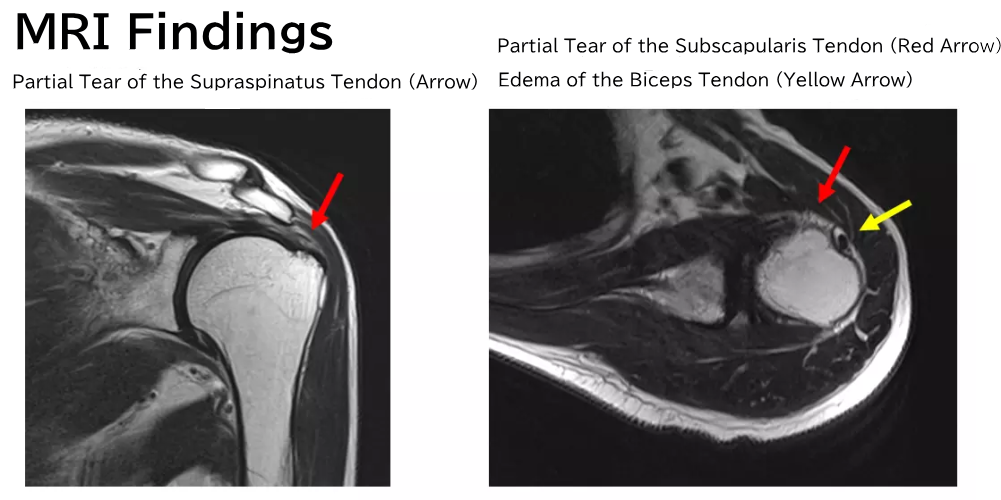
An injection was administered under ultrasound guidance. The injection consisted of 3cc of 1% Xylocaine. The procedure is demonstrated in the video below.
After the injection, the shoulder pain previously experienced at certain angles, particularly during abduction and external rotation, disappeared.
My left shoulder hurt, and I couldn't play the piano well enough
"My mother is a pianist. During periods of intense shoulder pain, she also complained of pain radiating to her neck. She mentioned that she couldn’t apply enough strength with her hand, making it difficult to press the piano keys firmly with her left hand.
I recorded a video of her playing the piano, and her left-hand movements gradually became slower. As an amateur observer, I thought her performance was wonderful (laughs), but she herself was not satisfied with her playing. I had her perform Chopin’s Fantaisie-Impromptu, and here is the video from that time."
Having decided to undergo surgery, the procedure was performed by myself as the operating surgeon. I will present only the scenes from the surgery here.
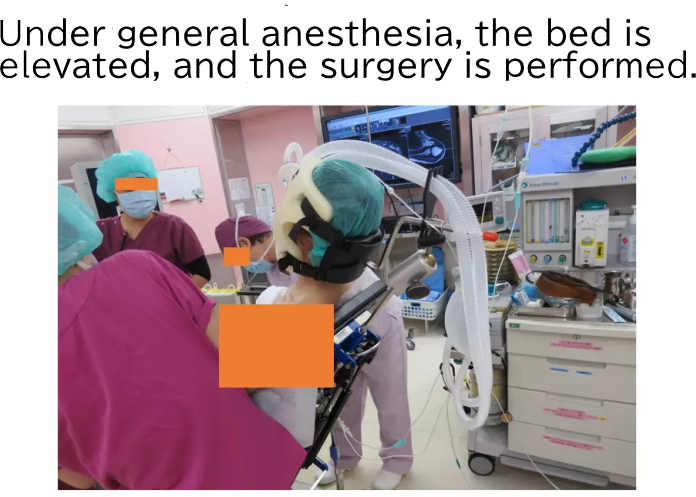
Surgical Procedure
An arthroscopic biceps tenodesis was performed.
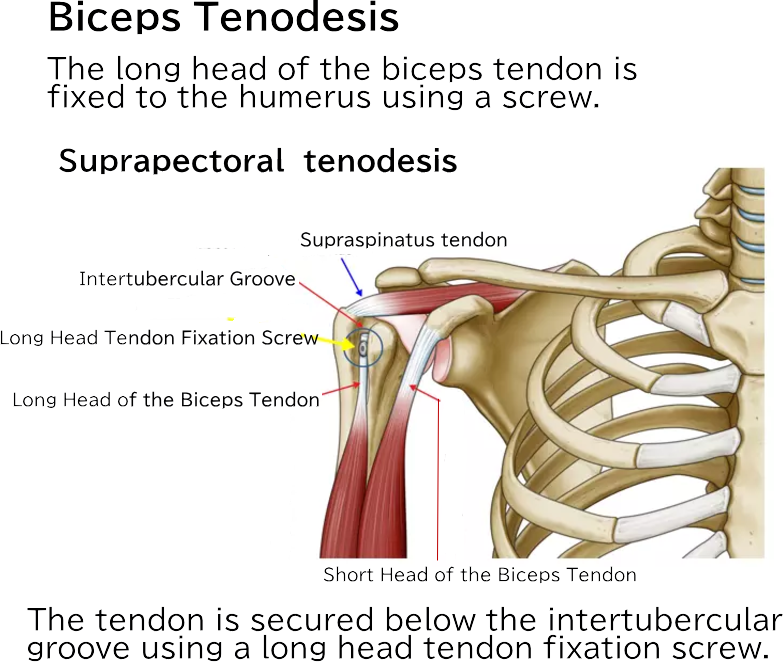
Postoperative Course
- A shoulder brace was worn for 5 weeks.
- The hospital stay lasted 6 weeks.
- At 2 months post-surgery, flexion reached only 90 degrees (the arm could be raised to shoulder height).
- At 3 months post-surgery, passive flexion reached 160 degrees (the arm could be raised above head level with assistance). However, self-achieved flexion was limited to 120 degrees (the arm could be raised to head level).
By around 3 months post-surgery, many individuals experience a reduction in shoulder pain. My mother also reported significantly less pain, and by 4 months post-surgery, she had resumed playing the piano. While she continued rehabilitation therapy, she kept attending due to slight limitations in range of motion and residual discomfort. Her rehabilitation sessions concluded one year after the surgery.
Five-Year Postoperative Progress
Five years after the surgery, my mother has not reported any issues related to her shoulder. Here, I will show you her movements in the examination room.
Even when I assist in moving her shoulder, the pain that was present in certain directions before the surgery is no longer there.
X-rays and MRI scans were taken, confirming that the biceps tendon had been securely attached to the humerus as a result of the surgery.
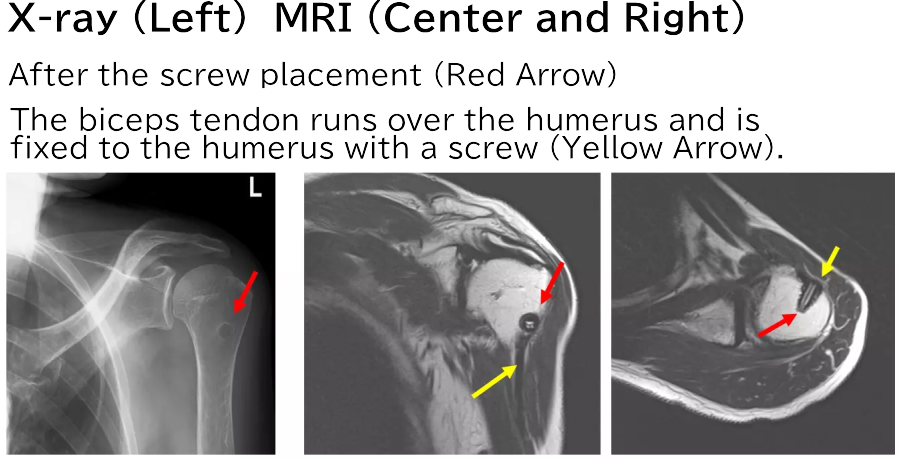
Five years after the surgery, she is able to play the piano confidently. I have watched her enjoying playing the piano post-surgery, and even from my perspective, it seemed like she was performing skillfully. Once again, she played Chopin's Fantaisie-Impromptu for me. If you’d like, please take three minutes to listen to her piano performance.
Summary
I reported the recovery process of my mother's condition, which was neither a rotator cuff tear nor frozen shoulder, but a less familiar diagnosis known as 'biceps tendon injury.'"
Please be aware that 'biceps tendon injury' is one of the conditions that can cause persistent shoulder pain.
I believe this article contains valuable information for patients who continue to experience shoulder pain despite being diagnosed with no abnormalities during testing.
Acknowledgments: I would like to express my gratitude to my mother for consenting to the publication of this article.
Please take a look at the concerns expressed by the individual in this video. For those whose biceps tendon is torn proximally (on the shoulder side) at the humerus and remains untreated, it does not necessarily result in severe upper arm pain. However, some individuals may still experience discomfort. Most of them do not report intense pain.
Symptoms
- A dull ache in the upper arm
- A general difficulty in applying strength to the arm
- Not significantly disruptive to daily life
These symptoms may persist when a biceps tendon injury (tear) is left untreated. How these symptoms are perceived depends on the individual's experience, and they can serve as a basis for deciding whether treatment is necessary.
上腕二頭筋腱断裂を処置しなかった場合
この動画の方の訴えをみてください。上腕二頭筋腱が近位側(肩の側)の上腕骨にきれていない、腱がきれっぱなしの方は上腕の激痛があるわけでないですが、疼痛がでる方がおられます。激痛でない方が多いです。
症状
・上腕がしくしくする
・腕がなんとなく力がはいりにくい
・生活でめちゃくちゃ困るわけでない
上腕二頭筋腱単独損傷(断裂)を放置した場合にこのような症状が残存します。この症状をどうとらえるかは患った方がどう感じるか、処置すべきであるかの判断材料にしてもらえればと思います。
Shoulder Diseases

We provide explanations for various shoulder conditions. Please use this as a general guide to determine which condition may apply to you.
- Common shoulder injuries by age group
- To those who neither have frozen shoulder nor rotator cuff tears
- Throwing Shoulder Disorder
- Rotator Cuff Tears and Rotator Cuff Injuries
- Recurrent Shoulder Dislocation
- Frozen Shoulder
- Shoulder Dislocation
- Acromioclavicular Joint Dislocation
- Chronic Acromioclavicular Joint Dislocation
- Frozen Shoulder
- Calcific Tendinitis of the Rotator Cuff
- Primary Degenerative Shoulder Arthritis
- Rotator Cuff Tear-related Degenerative Shoulder Arthritis
- Non-traumatic Shoulder Instability
- Biceps Tendon Injuries
- Surgical Trends for Throwing Shoulder in Baseball Players
